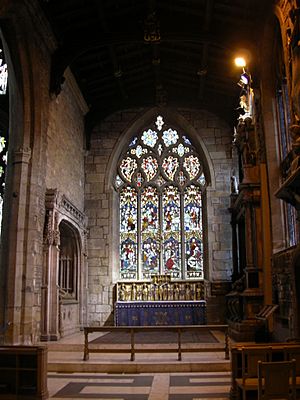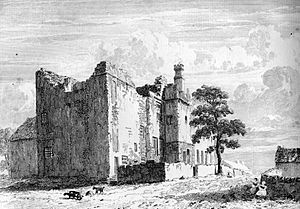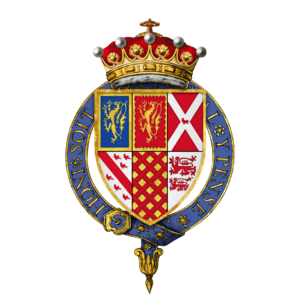George Talbot, 4th Earl of Shrewsbury facts for kids
Quick facts for kids
George Talbot
|
|
|---|---|
| 4th Earl of Shrewsbury 4th Earl of Waterford 10th Baron Talbot 9th Baron Furnivall |
|

Effigy of George Talbot on the Talbot monument in the Shrewsbury Chapel, Sheffield Cathedral. His first wife Anne is on his right side and his second, Elizabeth, on his left.
|
|
| Born | c. 1468 Shifnal, Shropshire, England |
| Died | 26 July 1538 (aged 70) Wingfield Manor, Derbyshire, England |
| Buried | Sheffield Cathedral, South Yorkshire, England |
| Noble family | Talbot Stafford |
| Spouse(s) | Lady Anne Hastings Elizabeth Walden |
| Issue | Francis Talbot, 5th Earl of Shrewsbury Lady Mary Talbot Lady Margaret Talbot Lady Elizabeth Talbot Lady Dorothy Talbot Hon. Richard Talbot Hon. Henry Talbot Hon. John Talbot Hon. John Talbot Hon. William Talbot Lady Anne Talbot Lady Anne Talbot |
| Father | John Talbot, 3rd Earl of Shrewsbury |
| Mother | Lady Catherine Stafford |
George Talbot, 4th Earl of Shrewsbury (born around 1468 – died July 26, 1538) was an important English nobleman. He was also known as the 4th Earl of Waterford and the 10th Baron Talbot. George was the son of John Talbot, 3rd Earl of Shrewsbury, and Lady Catherine Stafford. He held many important jobs and was a trusted advisor to two English kings.
Contents
Early Life and Titles
George Talbot was born in Shifnal, Shropshire, in 1468. When he was just five years old, in 1473, he inherited his father's titles. This made him the Earl of Shrewsbury. In 1475, he was made a Knight of the Bath, which is a special honor.
Serving the King
George Talbot was a brave and respected leader. He served both King Henry VII and his son, King Henry VIII.
Under King Henry VII
As a young man, George Talbot fought in battles for King Henry VII. He showed great courage at the Battle of Stoke in 1487. After this battle, he was given another high honor: he became a Knight of the Garter. This is one of the most important knightly orders in England.
In 1489, he joined an English army that went to Flanders to help the Emperor against the French. That same year, he became the godfather to Princess Margaret Tudor, King Henry VII's second child.
Under King Henry VIII
When Henry VIII became king, George Talbot continued to serve with loyalty. He became a very powerful person in the kingdom. He held many important roles, including being in charge of the King's household.
In 1512, he led the English army that invaded France. He was part of the Battle of the Spurs and helped capture the town of Thérouanne. He also attended the famous Field of the Cloth of Gold, a grand meeting between Henry VIII and the King of France. He was also given many other high political positions at court.
King Henry's Divorce
George Talbot supported King Henry VIII's desire to divorce his first wife, Queen Catherine. He even gave evidence during Queen Catherine's trial. He also signed a letter to the Pope, asking him to allow the divorce.
Later, he signed documents against Cardinal Thomas Wolsey, who was a powerful church leader. In 1530, Wolsey was arrested and brought to George Talbot's home in Sheffield. George and his family treated Wolsey kindly and tried to make him comfortable.
Stopping a Rebellion
In 1536, a big rebellion called the Pilgrimage of Grace broke out in the north of England. George Talbot quickly gathered his own soldiers to help the King. His quick actions and loyalty were very important in helping King Henry keep his crown.
He worked with other royal leaders to negotiate with the rebels. They met at Doncaster, where the rebel leader, Robert Aske, had gathered a large army. They agreed to a truce, and the rebels presented their demands to the King.
Family Life and Home

George Talbot had a large family and was very wealthy. He decided to make Sheffield his main home. He lived in Sheffield Castle, which was originally built by Lord Furnivall. This castle later became famous for holding Mary, Queen of Scots, as a prisoner. It was George's grandson, the 6th Earl, who was in charge of her imprisonment.
In 1516, George Talbot started building a new country house on a hill about two miles away from the castle. In 1520, he added a special chapel to the local church in Sheffield. This chapel was meant to be a family chapel and a burial place. Today, it is known as the Shrewsbury Chapel and is a historic part of Sheffield Cathedral.
George Talbot passed away in 1538 at the age of 70. He was buried in the Shrewsbury Chapel, next to his first wife, Lady Anne. In his will, he asked for a marble tomb with statues of himself and his two wives. This monument can still be seen in Sheffield Cathedral today.
Marriages and Children
George Talbot married Lady Anne Hastings before June 27, 1481. She was his second cousin. Lady Anne was one of Queen Katherine of Aragon's ladies-in-waiting.
George and Anne had 11 children:
- Francis Talbot, who became the 5th Earl of Shrewsbury.
- Lady Elizabeth Talbot.
- Lady Margaret Talbot.
- Lady Mary Talbot.
- Henry Talbot.
- John Talbot (two children named John died young).
- William Talbot.
- Richard Talbot.
- Lady Anne Talbot.
- Lady Dorothy Talbot.
After Anne passed away, George married Elizabeth Walden. They had two children:
- Lady Anne Talbot.
- John Talbot.
In Popular Culture
George Talbot has been shown in television and books.
- In the TV series The Tudors, the Earl of Shrewsbury is played by Gavin O'Connor. However, in the show, he appears much younger than he was in real life during the events like the Pilgrimage of Grace. Historically, he would have been around 70 years old at that time.
- He is also a small character in the novel The Man on a Donkey by H.F.M Prescott, which tells the story of the Pilgrimage of Grace.



